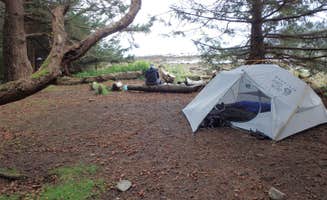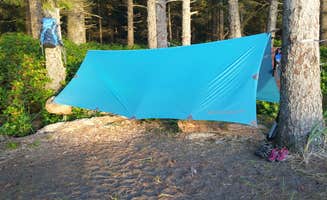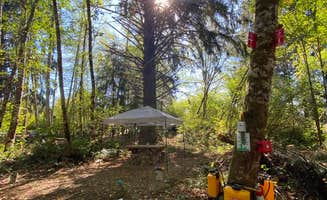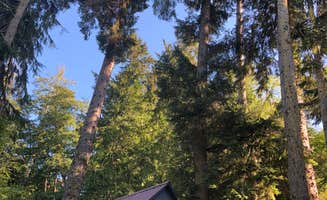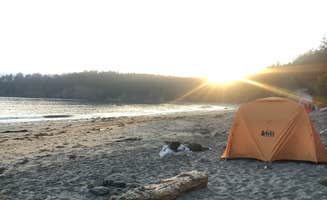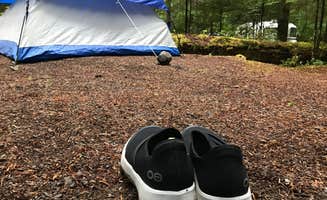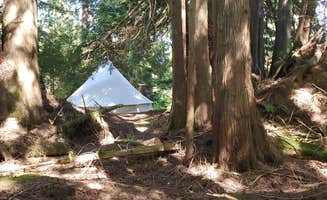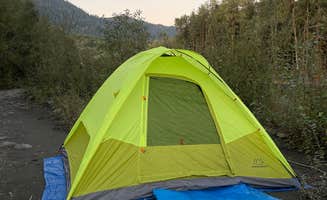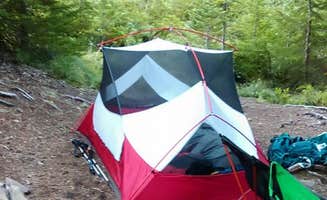The Olympic Peninsula near Neah Bay receives approximately 100 inches of annual rainfall, creating a lush temperate rainforest setting that surrounds many primitive camping areas. Most tent campsites near Neah Bay, Washington sit between 50-200 feet above sea level, providing relatively mild temperatures year-round despite frequent coastal fog and wind. Summer highs rarely exceed 70°F while winter lows typically stay above freezing, making tent camping feasible with proper gear during all seasons.
What to do
Explore petroglyphs: Visit Wedding Rocks between Cape Alava and Sand Point where ancient carvings can be observed during low tide. Preparation is essential since these are only accessible via hiking. "One really cool nearby feature is a series of petroglyphs carved by native people in a nearby stone. It does feel like a sacred place," notes a Wedding Rocks visitor.
Tidepooling: At low tide, examine marine ecosystems with abundant sea life at Shi Shi Beach. Many campers report seeing starfish, sea anemones, and other intertidal creatures. According to one visitor at Shi Shi Beach, "In the morning the tide pools were amazing! Colorful starfish and sea anemones everywhere."
Paddle Lake Ozette: For a different experience, canoe or kayak on the freshwater lake connecting to coastal campsites. "We stopped at this boat-only campground for lunch on a triangle paddle of Lake Ozette. It's a nice wide beach that makes for easy landings," explains a camper who visited Ericsons Bay.
What campers like
Privacy in popular areas: Despite summer crowds, many campers find isolation by walking farther down beaches. "After walking a mile or so down the beach, the tents spread out significantly and we were able to find relative solitude," shares a visitor to Second Beach.
Wildlife viewing opportunities: Campers frequently see marine mammals and birds from their tent sites. "We spent our first evening mesmerized by the seals on the rocks out in front of our camp and the eagles and blue herons flying overhead," notes a camper at Sand Point Camp Area.
Camping beneath forest canopy: The transition between dense forest and open beach creates ideal camping zones with natural wind protection. "The campsites are an up and down 3 mile trek out to the beach, and are then tucked in the trees along the edge of the beach... The campsites are all fairly open and have nice fire pits," explains a Cape Alava visitor.
What you should know
Permit requirements vary by location: Different areas require different permits, often from multiple agencies. "You don't need an Olympic wilderness permit, but you do need a reservation permit from the local tribe. You can get this at most stores and restaurants in town," clarifies a Shi Shi Beach visitor.
Water access is limited: Most coastal tent campsites near Neah Bay require filtering water from streams or carrying it in. One camper notes about Cape Alava: "This is one of several camping areas along this wild, beautiful stretch of coastline... There are very rustic pit toilets, so don't expect any glamping."
Seasonal crowds: Holiday weekends dramatically change the camping experience, especially at more accessible locations. According to one camper, "I camped here the Saturday before July 4th, so I should have expected crowds... After the pleasant 0.7 mile hike to the beach, I was amazed by how many tents I saw right by the end of the trail. It almost looked like a tent city!"
Tips for camping with families
Choose appropriate trail distances: Select hikes manageable for children as some beach access points require significant hiking. "While walking the beach we talked to a few parents who promised to go home and burn the books that told them the trails were easy for children, as they carried their tired children off the rocky beach," shares a Sand Point camper.
Consider alternatives during peak times: Private campgrounds near Olympic National Park can provide easier family camping options. "We stumbled on this after striking out on some First-come-first-serve sites in the area. Willow was amazing and hospitable as a host... They'll provide some water, and each site has its own toilet," explains a camper at Misty Willows Farm and Camp.
Plan for changing weather: Coastal conditions shift rapidly, requiring extra clothing and shelter options. "Our first evening in camp we witnessed the most epic coastal sunset to date! It painted the sky in shades of yellows and pinks melting into intense reds and purples. It was magical!" shares a Sand Point visitor who also noted rapid fog and weather changes.
Tips from RVers
Use dispersed camping as backup options: When developed campgrounds fill, several overflow areas accommodate last-minute campers. "I discovered Littleton horse camp out of necessity. I don't usually make reservations when I camp which proved quite difficult when journeying through the Olympic Peninsula during peak season," writes a visitor to Littleton Horse Camp.
Seek private alternatives: Some private land near popular destinations offers camping when public options fill. "Found this gem in the forest that recently opened with gorgeous tent campsites. I arrived with a travel trailer and was taken to an area that was still a work in progress, but offered dry camping in a private clearing amongst an incredibly dense forest," reports a camper who stayed at Dawleys Sol Duc River Campground.
Know parking limitations: Many primitive campsites have strict parking regulations requiring additional planning. "Overnight parking is in someone's front yard (about .7 miles from the trailhead), it was $10 a night," notes one Shi Shi Beach visitor describing the common practice of private parking arrangements near trailheads.



